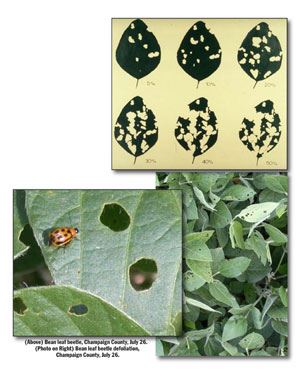Don’t Forget To Evaluate Soybeans For Defoliation In August
URBANA, ILL.
As we move past July and into early August, don’t neglect to monitor soybeans for defoliation that can be caused by several insect pests such as bean leaf beetles, grasshoppers, green cloverworms, and Japanese beetles. On July 26, I examined some soybeans in Champaign County and noted bean leaf beetle defoliation at levels of about 5 percent to 10 percent. When defoliation reaches 20 percent and there are 16 or more beetles per foot of row (during bloom to pod-fill stages of development), consider a rescue treatment. A 30 percent defoliation threshold is used before the bloom stage and when there are 5 or more beetles per foot of row. I did not detect sufficient beetles per foot of row, nor was defoliation at a 20 percent level, in the field I examined.
When making treatment decisions for soybean insect defoliators, keep the following questions in mind:
• What insects are causing the primary defoliation?
• Are densities of the primary defoliator increasing or decreasing?
• Have you examined plants for defoliation and presence of insects beyond field edges?
• Is the primary defoliation taking place in the upper canopy?
• Are insects also injuring developing pods?

Answering these questions should equip you to make a more informed treatment decision. If defoliation is primarily in the upper canopy, is not just along field edges, and has reached the suggested economic levels (20 percent to 30 percent), select an insecticide known to be effective against the primary target insect. Factors including cost, residual effectiveness, and preharvest interval need to be taken into account. Under the extremely hot conditions of late, pyrethroid insecticides may not prove as effective. Also, the defoliation thresholds used for many years were based on much lower commodity prices. Because the value of soybeans has increased significantly in recent times, lower levels of defoliation could translate into yield losses of economic importance. New research is need to evaluate defoliation and yield loss relationships with modern soybean varieties. Δ
DR. MICHAEL GRAY: Professor and Assistant Dean for Agriculture and Natural Resources Extension, University of Illinois